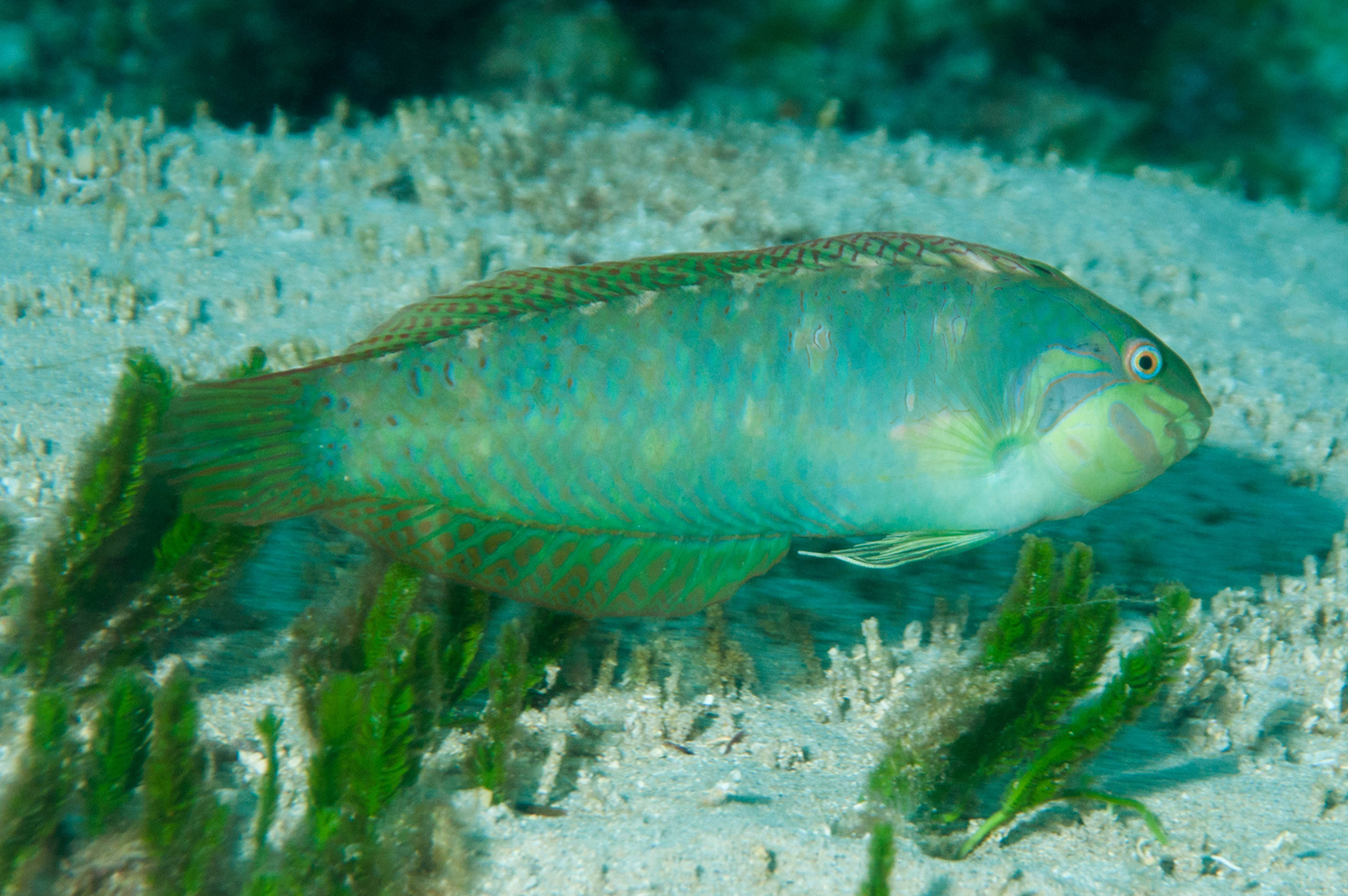- Classification
- ACTINOPTERYGII
- PERCIFORMES
- LABRIDAE
- Novaculoides
- macrolepidotus
Seagrass Wrasse, Novaculoides macrolepidotus (Bloch 1791)
Other Names: Sea Grass Wrasse

A male (terminal phase) Seagrass Wrasse, Novaculoides macrolepidotus, over and open rubble/sand/weed bottom at Norfolk Island in the Tasman Sea, April 2019 . Source: Malcolm Francis / iNaturalist.org. License: CC by Attribution-NonCommercial
Summary:
An secretive and well-camouflaged green to brownish-yellow wrasse. Males have a cluster of black spots on the rear of the body, a pair of curved dark brownish bands across the upper part of the gill cover behind the eye, and reddish spots distally on the dorsal, anal and caudal fins. Females have an irregular dark brown stripe or series of spots along the midside.
Seagrass Wrasses dive head first into seagrass or macroalgae when threatened.
Seagrass Wrasses dive head first into seagrass or macroalgae when threatened.
Cite this page as:
Bray, D.J. 2019, Novaculoides macrolepidotus in Fishes of Australia, accessed 03 Jul 2025, https://fishesofaustralia.net.au/home/species/258
Seagrass Wrasse, Novaculoides macrolepidotus (Bloch 1791)
More Info
|
Distribution |
Rowley Shoals, Western Australia, and the far northern Great Barrier Reef, Queensland, to Seal Rocks, New South Wales; also Cocos (Keeling) Islands in the eastern Indian Ocean, and Lord Howe Island and Norfolk Island in the Tasman Sea. Elsewhere the species occurs in the tropical, Indo-west-central Pacific. Inhabits seagrass beds, algal-covered sandy and rubble reef flats in lagoons, and mangrove channels. The Seagrass Wrasse is secretive and well-camouflages amongst the vegetation. |
|
Features |
Dorsal fin IX, 13; Anal fin III, 13; Pectoral fin 12; lateral line scales 19-20 + 4-6. Body slender, 3.5-3.9 in SL. |
|
Colour |
Adults are usually bright green, while juveniles are variable in colour ranging from brown to green, usually with a blotched pattern. |
|
Feeding |
Feeds on benthic invertebrates. |
|
Remarks |
Juvenile and subadult Seagrass Wrasses mimic venomous waspfishes of the genus Ablabys. |
|
Species Citation |
Labrus macrolepidotus Bloch, 1791, Naturgeschichte der ausländischen Fische 5: 135, pl. 284(2). Type locality: East Indies. |
|
Author |
Bray, D.J. 2019 |
|
Resources |
Australian Faunal Directory |
Seagrass Wrasse, Novaculoides macrolepidotus (Bloch 1791)
References
Allen, G.R. 1997. Marine Fishes of Tropical Australia and South-east Asia. Perth : Western Australian Museum 292 pp. 106 pls. (as Novaculichthys macrolepidotus)
Allen, G.R. & Erdmann, M.V. 2012. Reef fishes of the East Indies. Perth : Tropical Reef Research 3 vols, 1260 pp.
Allen, G.R., Hoese, D.F., Paxton, J.R., Randall, J.E., Russell, B.C., Starck, W.A., Talbot, F.H. & Whitley, G.P. 1976. Annotated checklist of the fishes of Lord Howe Island. Records of the Australian Museum 30(15): 365-454 figs 1-2 (as Hemipteronotus macrolepidotus)
Allen, G.R. & Smith-Vaniz, W.F. 1994. Fishes of Cocos (Keeling) Islands. Atoll Research Bulletin 412: 1-21.
Bloch, M.E. 1791. Naturgeschichte der ausländischen Fische. Berlin : J. Morino Vol. 5 152 pp. pls 253-288.
Bourjon, P. & Fricke, R. 2016. First record of the seagrass wrasse, Novaculoides macrolepidotus (Actinopterygii: Perciformes: Labridae), from Reunion Island, southwestern Indian Ocean, with a brief description of its colour pattern variation, escape and reproductive behaviour. Acta Ichthyologica et Piscatoria 46(2): 109-114. DOI: 10.3750/AIP2016.46.2.06, open access
Craig, M., Rocha, L. & Liu, M. 2010. Novaculichthys macrolepidotus.
Randall, J.E. & Spreinat, A. 2004. The subadult of labrid fish Novaculoides macrolepidotus, a mimic of waspfishes of the genus Ablabys. aqua, Journal of Ichthyology and Aquatic Biology 8(2): 45-48.






